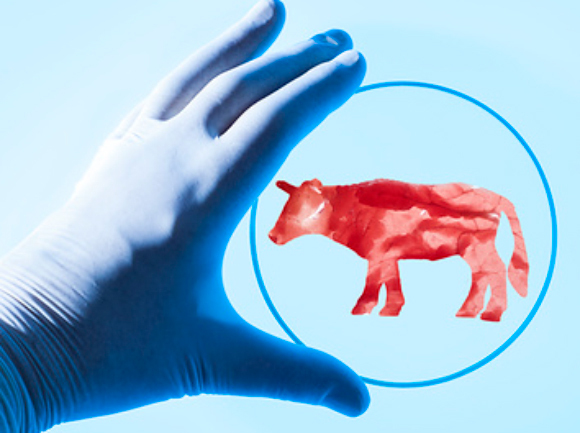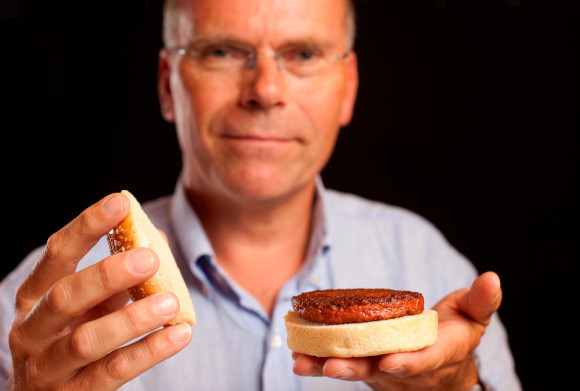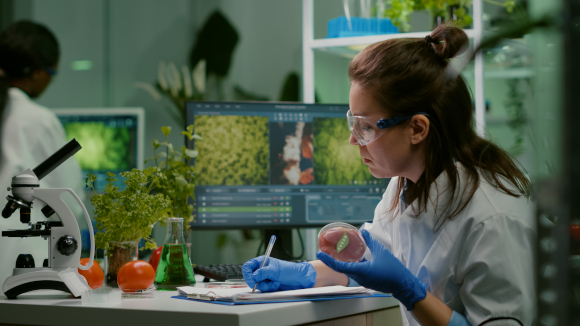New technologies already allow us to grow animal tissues without harming or killing. How is it done, and what are the consequences for the environment?
In recent years, there has been mounting public criticism of the animal food industry, particularly with respect to meat. Many critics focus on the ethical aspects of the rearing conditions of livestock, their transportation, and above all - their slaughter. Beyond the ethical aspect, this industry also has destructive ecological consequences: animal food cultivation requires large areas of farmland that take over natural habitats and endanger the existence of numerous plants and animal species. Deforestation for agricultural needs and livestock waste contribute greatly to greenhouse gas emissions and reduce their absorption by the soil, thus accelerating processes of climate change and global warming.
Nevertheless, meat is the primary source of whole protein in human nutrition, and it contains many other nutrients - including vitamin B12, entirely absent from vegan, plant-based diets, as well as omega-3, iron and zinc. Due to the constant growth of the world’s population, the demand for meat has risen globally by tens of percent in recent years, resulting in a significant increase in global meat production, with an expected continuation of this trend
Given these challenges, there is a growing imperative to develop viable meat alternatives that mirror the nutritional profile of animal-derived meats. These alternatives must be affordable and accessible to the public. Since humans are picky, these meat substitutes must resemble the real thing in taste, texture and appearance. Only in this way will consumers agree to switch en masse to consuming meat that was produced without harming animals or the environment.

Lab-Grown meat could eliminate animal suffering and killing. Cultured meat, illustration | source: Cristina Pedrazzini, Science Photo Library
Growing Meat in the Laboratory
Most of the meat we consume is muscle tissue from living organisms, interwoven with connective tissue and fats. Within the body's natural environment, muscles develop from single cells in a dense network of proteins known as the extracellular matrix during fetal development. This matrix provides the cells with stable support for cell division, allowing the formation of three-dimensional muscle fibers, and eventually, developed muscle tissue.
Cultured meat is cellular tissue grown under laboratory conditions, designed to emulate a genuine cut of meat. To produce tissue similar to that of a living organism, the cells require structural support, much like a climbing plant. Consequently, the prevalent method for cultured meat production is growing cells on a sponge-like scaffold, which lends physical support, enabling the cells to adhere to one another and stick to each other, and proliferate repeatedly to form an entire tissue.
One of the challenges with this method is the difficulty in separating the cultured tissue from the scaffold on which it grows. Thus, the scaffold needs to be digestible, easily broken down in our digestive system, and devoid of any impact on the meat's flavor. Presently, most producers of cultured meat employ a protein-based scaffold. In the past they mainly used animal-derived protein, such as collagen or gelatin. Today, more and more companies, including Aleph Farms and Future Meat, are increasingly adopting plant proteins such as soybeans for this purpose.
The initial step involves extracting a sample of stem cells from the target living muscle tissue.While most of the cells in animal bodies are mature cells that are specialized in a specific function, such as skin cells, nerve cells, or white blood cells, stem cells are undifferentiated cells that have not been assigned their final function, and chave the potential to transform (differentiate) into multiple different tissue types. These stem cells are grown in the laboratory under conditions that allow them to replicate continuously, obviating the need for further samples. Consequently, the role of the animal in meat production concludes, leaving no inherent reason for its premature demise.
The stem cells are grown in the presence of substances that allow them to differentiate into mature muscle cells. Once they have differentiated and commenced replication, the cells are left to grow on the protein scaffold, taking on the shape of the desired meat cut. Alternatively, the cells can also grow without the scaffold, in which case the produced tissue will not obtain any particular structure and will be suitable for creating ground meat products such as patties.
One of the current challenges of the meat culturing industry is its reliance on animal serum - the liquid blood component, which includes proteins, hormones, minerals, and nutrients necessary for cell growth. To cultivate cells for example, for a cultured beef steak, serum from living cow fetuses, which contains essential substances for the cells’ proliferation, is added.
To produce entirely vegan cultured meat, without the use of any animal-derived substances aside from the initial cell sample, an alternative growth medium must be found that can nourish the cells cost-effectively over time. A paper published in Nature in 2022 represents a significant step towards achieving this goal. The researchers managed to develop a liquid that supported cell growth with minimal use of real, animal-derived serum. The future may see the development of a complete blood serum substitute, liberating cultured meat production from its reliance on animal-derived products.
Another issue is related to the inherent limitations of using tissue specific stem cells. In contrast to embryonic stem cells, which can develop into any cell type in the body, mature stem cells are cells that have already undergone initial differentiation. Consequently they can continue differentiating only into cells within their specific tissue type. Thus, it is not possible to take stem cells from any tissue and convert them into muscle cells. Second, mature stem cells can only undergo a finite number of cell divisions
To overcome this limitation, which necessitates periodic sampling of new stem cells, biotech companies induce continuous cell division by disrupting the mechanism responsible for halting it. In the future, it may be possible to achieve this same outcome by utilizing another type of stem cells, known as induced stem cells. These are mature cells that have undergone genetic programming designed to revert them to the state of embryonic stem cells. As of now, the technology for producing induced stem cells from livestock tissues is still in its early stages.

Aspiring for the perfect replica: 3-D Printing of a piece of meat | Photo: Dmytro Zinkevych, Shutterstock
Printing Meat
Currently, most companies developing lab-grown meat start by extracting samples from muscle cells only. Some also extract samples of fat cells in order to enrich the flavor and texture of the meat they produce. After the cells of both types have grown, the products are ground together to produce minced meat that can be used for making burgers and other patty-type products. But to produce a more complex meat product, such as a steak, additional techniques from the realm of tissue engineering are required.
Tissue engineering is a developing field; its main aim is to enable us to grow organs for transplantation from the recipient's own stem cells, with no need for organ transplants. Similar to cultured meat production, tissue engineering requires some kind of scaffold to construct the tissue. The substances suitable for use as scaffold in tissue engineering are those that the body can recognize without triggering an immune response, and that the body can break down, such that only the implanted cell tissue eventually remains.
The cultured meat industry benefits from advancements in tissue engineering, for example, by adopting methods for producing the scaffold. One such method involves printing the tissues with a 3-D printer, where printing is performed layer by layer, but instead of ink or plastic, living cells are injected into the printer. This method eliminates the need for a protein scaffold, allowing various cell types to be layered in a desired form, to form complex tissues that closely resemble actual pieces of meat.
Another challenge in the production of a complex piece of meat, such as steak, is the difficulty to achieve the desired thickness. In cuts thicker than one centimeter, sufficient oxygen cannot reach the center of the tissue, causing the cells there to die. One solution for this problem is to print a network of blood vessels capable of transporting oxygen to the deeper tissue layers, mirroring the natural process in a living body, with muscle cells growing around this printed vascular network. This technology is also still in its infancy, and not yet suitable for large-scale industrial production.
Tissue engineering for transplantation requires the production of a complex tissue that includes muscle cells, fat cells, connective tissue, blood vessels, nerves and even functioning immune cells. From this perspective the cultured meat industry enjoys a significant advantage. It doesn’t require all the complexity of a functioning tissue in a living body, and can make do with an intermediate solution that includes only the components essential for nutrition. It is commonly accepted today that the minimum requirement for producing cultured meat is muscle cells.
In 2020, 3D Bioprinting Solutions, and a Russian branch of the fast food chain Kentucky Fried Chicken (KFC), signed a cooperation agreement to print cultured chicken nuggets. Likewise, the Israeli company, SuperMeat produces cultured chicken in the form of a chicken burger, thus precluding the need for a tissue-building scaffold, and relies solely on cell cultivation. Two years ago, the company even partnered with a nearby restaurant with an open kitchen, providing customers with a view of the production process.

330 thousand dollars per serving. The first lab-grown hamburger cultured by Mark Post | David Parry/PA, Mosa Meat
The Cost of Innovation
One of the primary concerns occupying most of the companies in the cultured meat industry is the high production cost. In 2013, Mark Post of Maastricht University produced the first cultured hamburger with a staggering trice tag of 330 thousand dollars for a roughly 140-rm serving. At that stage, it was clear that the technology existed, but it needed to be significantly reduced in price so that cultured meat could be sold in food chains.
Upside Foods, the first commercial company in the field of cultured meat, was established in early 2016, heralding a surge of dozens of similar ventures throughout the world - signaling growing confidence in the technology’s market potential. The first country to approve the sale of cultured meat was Singapore, in late 2020, when it allowed Eat Just, a company that develops cultured eggs and meat, to distribute a limited quantity of chicken nuggets. To date, no other company has achieved industrial-scale sales of cultured meat.
In his 2012 paper, Post explained that to produce the first hamburger he used a sample of cow satellite cells - mature stem cells that had undergone initial differentiation into muscle tissue. These cells are capable of becoming several types of muscle cell, following injury or for the purpose of muscle development in response to physical activity. They also have the capacity for sustained growth, which results in the formation of muscle fibers, and ultimately, fully developed muscle tissue.
Post grew the cultured meat on a collagen scaffold, which has a tight structure that applies pressure to the cells, similar to the pressure created during physical training. Thus the cells formed mature and developed muscle fibers. The technology for growing satellite cells in the laboratory was already developed at the beginning of the current millennium, mainly for the purpose of creating tissues for transplantation or for research purposes. Post was the first to use them to create cultured meat for human consumption.
In recent years the taste of cultured meat has also dramatically improved. Despite the impressive technological achievement of Post and his colleagues in the previous decade, its taste test, which was broadcast live, did not pass successfully. The tasters declared that its taste was ‘bland and neutral’, but praised its texture, which in their opinion resembled that of a real hamburger. The patty was made solely of muscle cells, without the fat cells present in real beef, and this affected its flavor and quality.
Since then, significant progress has been made in the quality of culture meat. In December 2020, an event by Aleph Farms featuring a tasting of cultured meat was deemed successful. In early 2022 SuperMeat conducted a live blind taste test for a chicken patty, and it successfully passed the test.

Can significantly reduce the risk of diseases, and perhaps even reduce greenhouse gas emissions. A scientist examining cultured meat | Photo: DC Studio, Shutterstock
A Healthier, Greener Alternative
The outbreak of the COVID-19 pandemic in early 2020 reinforced the concern about viruses that can be transmitted from animals to humans. Even bacteria such as salmonella and listeria can pose health risks to humans through food consumption - as seen in cases involving eggs consumption. The use of cultured meat can significantly reduce the concern of disease transmission. By eliminating the need to raise animals for food, we also eliminate the potential contact with the viruses and bacteria that thrive within their bodies. Similarly, growing cultured fish tissue will have an additional advantage by saving us from exposure to heavy metals and other toxins that accumulate naturally in the tissues of large fish like tuna.
Another important contribution of the transition to cultured meat relates to the battle to curb global warming. As part of their digestive process, cows and sheep emit large quantities of methane, a potent greenhouse gas that contributes to climate change. Substituting the consumption of conventional beef and lamb with cultured meat is expected to strongly reduce global methane emissions and help curb the climate crisis. Moreover, such a step could significantly decrease the area of rangelands required and the area of farmland used to grow food for livestock, while conserving substantial amounts of clean water.
Nevertheless, like any other industry, cultured meat production also has an environmental cost. Cultivating meat cultures necessitates the use of electricity-consuming devices, such as incubators and bioreactors, demanding more energy than traditional livestock farming. Given that a significant portion of electricity production today relies on polluting fuels that lead to the emission of the greenhouse gas, carbon dioxide, and other pollutants, culturing meat may cause damage akin to that associated with livestock methane emissions. On the other hand, transporting animals from place to place also consumes fuel, and the production of cultured meat can potentially reduce the burning of fuel required for transportation. Furthermore, the use of renewable energy in both the cultured meat industry and livestock rearing can help reduce greenhouse gas emissions.
When the technologies for producing cultured meat are sufficiently developed, it may be possible to enrich the meat with additional nutrients, such as vitamins and minerals. It should also be possible to control the amount of saturated fat in the piece of cultured meat and thus reduce the risk of cardiovascular disease. With further technological development, large-scale production of cultured meat in specialized facilities may significantly reduce the need for transportation, saving extensive use of fuel and thus significantly reducing greenhouse gas emissions.
